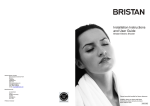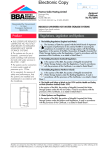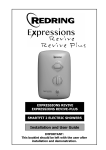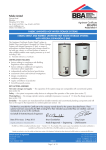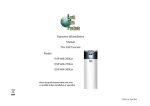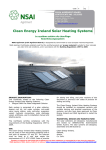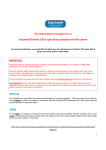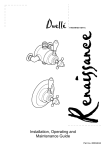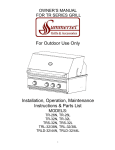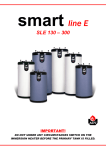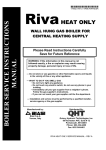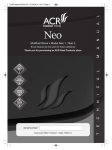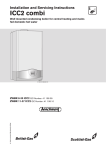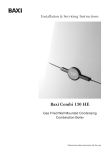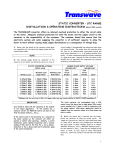Download Electronic Copy - RIBA Product Selector
Transcript
Electronic Copy Kwikot Limited (53.3) Aberdeen Road P O Box 389 Benoni 1500 Republic of South Africa Tel: 00 27 11 914 2300 Fax: 00 27 11 914 1286 e-mail: [email protected] website: www.kwikot.co.za Designated by Government to issue European Technical Approvals CI/SfB X Agrément Certificate No 96/3253 Third issue* KWIKOT UNVENTED HOT WATER STORAGE SYSTEMS Système d’eau chaude sanitaire Heißwasserbereiter Product • THIS CERTIFICATE RELATES TO KWIKOT UNVENTED HOT WATER STORAGE SYSTEMS. • The systems are for use in domestic, commercial and public buildings with domestic hot and cold water services to BS 6700 : 1997. • The systems are for connection to mains water supply at pressures up to 12 bar. • Kwikot is distributed in the UK by A & J Gummers, Unit H, Redfern Park Way, Tyseley, Birmingham B11 2DN and Stockgap Ltd, 209 Watling Street, Dartford, Kent DA1 6EG. Regulations — Detail Sheet 1 1 The Building Regulations 2000 (as amended) (England and Wales) The Secretary of State has agreed with the British Board of Agrément the aspects of performance to be used by the BBA in assessing the compliance of unvented hot water storage systems with the Building Regulations. In the opinion of the BBA, Kwikot Unvented Hot Water Storage Systems, if used in accordance with the provisions of this Certificate, will meet or contribute to meeting the relevant requirements. Requirement: G3 See the tinted areas of the Safety section and the relevant tinted area of the Installation section of the accompanying system Detail Sheets. Comment: Requirement: L1 Comment: Dwellings See the tinted areas of the Hot water storage and supply section of the accompanying system Detail Sheets. Systems with a capacity of more than 150 litres that are not heated by off-peak electricity should be fitted with a time switch. Comment: Requirement: Hot water storage Regulation 7 Materials and workmanship The systems are acceptable. continued Readers are advised to check the validity of this Certificate by either referring to the BBA’s website (www.bbacerts.co.uk) or contacting the BBA direct (Telephone Hotline 01923 665400). continued • It is essential, for reasons of safety and performance, that the systems are installed and maintained in accordance with this Certificate. These Front sheets must be read in conjunction with the accompanying Detail Sheets which provide information on components and the different systems. Electronic Copy 2 The Building Standards (Scotland) Regulations 1990 (as amended) In the opinion of the BBA, Kwikot Unvented Hot Water Storage Systems, if used in accordance with the provisions of this Certificate, will satisfy or contribute to satisfying the various Regulations and related Technical Standards listed below. Regulation: Standard: 10 B2.1 Fitness of materials and workmanship Selection and use of materials, fittings, and components, and workmanship The product can contribute to a construction meeting this Standard. See the Installation part of the relevant Detail Sheet. Comment: Standard: Comment: Regulation: Standards: B2.2 Selection and use of materials, fittings, and components, and workmanship The product is an acceptable material. 22 J11.2 to J11.4 The systems are fitted with a thermostat which meets the requirements of Standard J5.2a. Systems having a capacity of more than 150 litres, and where the water is not heated by off-peak electricity, require a time switch that can start up and shut off the supply of heat. See the tinted areas of the Hot water storage and supply section of the accompanying system Detail Sheets. Comment: Standards: J11.6 and J11.7 27 P2.6 Miscellaneous hazards Danger from accident — Discharge of steam or hot water The systems will satisfy the requirements of this Standard. See section 16 of each system Detail Sheet. Comment: Regulation: Standard: Buildings in purpose groups 2 to 7 — Building services (space heating and hot water) — Insulation of pipes, ducts and vessels The storage vessels have a heat loss of not more than 90 Wm⫺2 and thus satisfy these Standards. Comment: Regulation: Standard: Conservation of fuel and power Buildings in purpose groups 2 to 7 — Building services (space heating and hot water) — Space heating controls 28 P3.1 Miscellaneous hazards Danger from malfunction of an unvented hot water storage system — Unvented hot water storage system The systems are constructed to prevent the temperature of the stored water at any time exceeding 100°C and to provide adequate protection from malfunctions of the system. See the tinted areas of the Safety section of the accompanying system Detail Sheets. Comment: 3 The Building Regulations (Northern Ireland) 2000 In the opinion of the BBA, the position of Kwikot Unvented Hot Water Storage Systems, if used in accordance with the provisions of this Certificate, will satisfy or contribute to satisfying the various Building Regulations as listed below. Regulation: Comment: Regulation: B2 Fitness of materials and workmanship The systems are acceptable. F3 Space heating, hot water supply and artificial lighting systems The systems are fitted with a thermostat meeting the requirements of this Regulation. To comply with the deemed-to-satisfy provision set out in Technical Booklet F : 1991 Conservation of fuel and power Section 2, systems having a capacity of more than 150 litres, and where the water is heated by means other than off-peak electricity, must be used in conjunction with a time switch to shut off the supply of heat when the building is not occupied. See the tinted areas of the Hot water storage and supply section of the accompanying system Detail Sheets. Comment: Regulation: Comment: Regulation: F4 Insulation of pipes, ducts and hot water storage vessels The systems will satisfy the requirements of this Regulation. P5 Unvented hot water storage systems The systems incorporate suitable safety devices to meet the requirements of this Regulation. See the tinted areas of the Safety section of the accompanying system Detail Sheets. Comment: Regulation: P6 Deemed-to-satisfy provision for an unvented hot water storage system The systems will meet the deemed-to-satisfy provisions of Regulation P6. Comment: 2 Electronic Copy 4 Construction (Design and Management) Regulations 1994 (as amended) Construction (Design and Management) Regulations (Northern Ireland) 1995 (as amended) Information in this Certificate may assist the client, planning supervisor, designer and contractors to address their obligations under these Regulations. 2 Delivery and site handling, 6 Safety, 7 Properties in relation to fire, 12 Maintenance and 17 Installation procedure of the relevant Detail Sheets. See sections: 5 The Health and Safety at Work etc Act 1974 and the Health and Safety at Work (Northern Ireland) Order 1978 In buildings subject to this Act and Order, regular maintenance is a requirement. See section 12 of each system Detail Sheet. 6 Water Supply (Water Fittings) Regulations 1999 England and Wales, Water Byelaws 2000, Scotland and the Water Regulations, Northern Ireland England and Wales The product satisfies the requirements of the water regulations, if used and installed in accordance with this Certificate. Scotland The product satisfies the requirements of the water byelaws, if used and installed in accordance with this Certificate. Northern Ireland The product satisfies the requirements of the water regulations, if used and installed in accordance with this Certificate. 7 The Electrical Equipment (Safety) Regulations 1994 and the Electromagnetic Compatibility Regulations 1994 These Regulations implement the Low Voltage Directive 73/23/EEC (as amended by the CE Marking Directive 93/68/EEC) and the Electromagnetic Compatibility Directive 89/336/EEC and require manufacturers to carry out assessment of their products against the criteria given in the Directives. Declarations of Conformity have been provided by Kwikot Limited. The BBA has not assessed the product for compliance with these Directives. 3 Bibliography Electronic(a) Copy are maintained at or above the levels which BS 6700 : 1997 Specification for design, installation, testing and maintenance of services supplying water for domestic use within buildings and their curtilages Conditions of Certification 8 Conditions 8.1 This Certificate: (a) relates only to the product that is described, installed, used and maintained as set out in this Certificate; (b) is granted only to the company, firm or person identified on the front cover — no other company, firm or person may hold or claim any entitlement to this Certificate; (c) is valid only within the UK; (d) has to be read, considered and used as a whole document — it may be misleading and will be incomplete to be selective; (e) is copyright of the BBA; (f) is subject to English law. 8.2 References in this Certificate to any Act of Parliament, Regulation made thereunder, Directive or Regulation of the European Union, Statutory Instrument, Code of Practice, British Standard, manufacturers’ instructions or similar publication, are references to such publication in the form in which it was current at the date of this Certificate. 8.3 This Certificate will remain valid for an unlimited period provided that the product and the manufacture and/or fabrication including all related and relevant processes thereof: have been assessed and found to be satisfactory by the BBA; (b) continue to be checked as and when deemed appropriate by the BBA under arrangements that it will determine; and (c) are reviewed by the BBA as and when it considers appropriate. 8.4 In granting this Certificate, the BBA is not responsible for: (a) the presence or absence of any patent, intellectual property or similar rights subsisting in the product or any other product; (b) the right of the Certificate holder to market, supply, install or maintain the product; and (c) the actual works in which the product is installed, used and maintained, including the nature, design, methods and workmanship of such works. 8.5 Any recommendations relating to the use or installation of this product which are contained or referred to in this Certificate are the minimum standards required to be met when the product is used. They do not purport in any way to restate the requirements of the Health & Safety at Work etc Act 1974, or of any other statutory, common law or other duty which may exist at the date of this Certificate or in the future; nor is conformity with such recommendations to be taken as satisfying the requirements of the 1974 Act or of any present or future statutory, common law or other duty of care. In granting this Certificate, the BBA does not accept responsibility to any person or body for any loss or damage, including personal injury, arising as a direct or indirect result of the installation and use of this product. In the opinion of the British Board of Agrément, Kwikot Unvented Hot Water Storage Systems are fit for their intended use provided they are installed, used and maintained as set out in this Certificate. Certificate No 96/3253 is accordingly awarded to Kwikot Limited. On behalf of the British Board of Agrément Date of Third issue: 10th September 2004 Chief Executive *Original Front Sheets issued 23rd September 1996. This amended version includes change of product name, and reference to the revised national Building Regulations, Water Supply Regulations, Construction (Design and Management) Regulations, and new Conditions of Certification. British Board of Agrément P O Box No 195, Bucknalls Lane Garston, Watford, Herts WD25 9BA Fax: 01923 665301 ©2004 e-mail: [email protected] website: www.bbacerts.co.uk For technical or additional information, contact the Certificate holder (see front page). For information about the Agrément Certificate, including validity and scope, tel: Hotline 01923 665400, or check the BBA website. Electronic Copy CI/SfB (53.9) Kwikot Limited X Certificate No 96/3253 KWIKOT UNVENTED HOT WATER STORAGE SYSTEMS DETAIL SHEET 2 Second issue* Components • THIS DETAIL SHEET LISTS THE COMPONENTS APPROVED FOR USE ON KWIKOT UNVENTED HOT WATER STORAGE SYSTEMS. • Each product Detail Sheet lists the components that are required to be factory fitted and others which are supplied separately for fitting by the installer. • The BBA has assessed each of the components as suitable for purpose. This Detail Sheet must be read in conjunction with the Front Sheets and the relevant Detail Sheets. Component Manufacturer/supplier and component number Setting Size Line strainer Reliance Water Controls LS75 — ¾” Pressure reducing valve Reliance 312 Watts Redupress 3 bar 3 bar ¾” ¾” Combined check valve and expansion valve Reliance 2014 5 bar ½” Combined temperature and pressure relief valve Reliance Water Controls HT55 EVR Watts SFR 52550UK 90°C/7 bar ½” 90°C/6 bar ¾” 3 bar 16 litres — 22 mm to 28 mm 35° to 75°C 35° to 70°C 2¼” 2¼” Expansion vessel Altechnic Zilmet Tundish Reliance Water Controls Immersion heater Redring LU11TC Thermtec AFSTA-327 Thermostat non-self-resetting thermal cut-out Integral part of immersion heater Indirect thermostat IMIT LSC2 Indirect non-self-resetting thermal cut-out IMIT LSC1-T80 Motorised valve(1) Honeywell V4043 Danfoss DMV2C Sunvic SZV2212F 80°C 35° to 80°C 85°C (1) It is essential on indirectly heated systems that the motorised valve supplied with the system is installed and is not substituted by any other motorised valve which may exist and be in service at the site of installation, eg a motorised valve installed in a central heating circuit. Readers are advised to check the validity of this Detail Sheet by either referring to the BBA’s website (www.bbacerts.co.uk) or contacting the BBA direct (Telephone Hotline 01923 665400). Electronic Copy On behalf of the British Board of Agrément Date of Second issue: 10th September 2004 Chief Executive *Original Detail Sheet issued 23rd September 1996. This revised version includes change of product name and reference to the Watts valves and Thermtec immersion heater. British Board of Agrément P O Box No 195, Bucknalls Lane Garston, Watford, Herts WD25 9BA Fax: 01923 665301 ©2004 e-mail: [email protected] website: www.bbacerts.co.uk For technical or additional information, contact the Certificate holder (see front page). For information about the Agrément Certificate, including validity and scope, tel: Hotline 01923 665400, or check the BBA website. Electronic Copy CI/SfB (53.3) Kwikot Limited X Certificate No 96/3253 KWIKOT DIRECT UNVENTED HOT WATER STORAGE SYSTEM DETAIL SHEET 3 Second issue* Product • THIS DETAIL SHEET RELATES TO THE KWIKOT DIRECT UNVENTED HOT WATER STORAGE SYSTEM, WITH A RANGE OF CAPACITIES FROM 150 TO 210 LITRES, A NOMINAL OPERATING PRESSURE OF 3.0 BAR AND FITTED WITH TWO 3 kW IMMERSION HEATERS. • The system is for use with mains or other suitable potable water supply pressures up to and including 12 bar. • Satisfactory outlet flow rates can only be achieved where the flow rate available at the entry to the system is adequate (see section 5 of this Detail Sheet). • It is essential, for reasons of safety and performance, that the product is installed and maintained in accordance with the requirements of this Detail Sheet by a competent person (see section 12, regarding Maintenance and section 15 for the definition of a competent person). This Detail Sheet must be read in conjunction with the Front Sheets and Detail Sheet 1, which give the Conditions of Certification and the product’s position regarding the Building Regulations, respectively. Technical Specification 1 Description 1.1 The Kwikot Direct Unvented Hot Water Storage System is for use in domestic, commercial and public buildings for connection to domestic hot and cold water services to BS 6700 : 1997, and comprises the components shown in Figure 1. The storage capacities and main dimensions are listed in Table 1. 1.2 The system generally comprises a steel storage cylinder, enamelled on the interior surfaces and factory fitted with two 3 kW immersion heaters. The models are for free-standing installations. 1.3 The cylinder is insulated with polyurethane (PU) hard foam and covered with a white, epoxy-coated steel sheet. 1.4 For safety of the system, electrical control devices and the combined temperature and pressure relief valve are factory fitted. Other components are supplied separately for fitting on site by a competent person (see Figure 1 and section 2.1). 1.5 Factory production control is exercised during the manufacture and assembly of each of the components including visual examination, dimensional checks and performance tests. Each storage cylinder is pressure tested and examined for leaks during manufacture and prior to dispatch. 2 Delivery and site handling 2.1 The system is delivered in a cardboard carton protected internally with polystyrene supports and wrapped in a plastic bag. The following items (see also Detail Sheet 2) are supplied separately with each storage cylinder for fitting on site by a competent person, all other components are factory fitted: • cold water control valves — to include a pressure control valve (pressure limiting or pressure reducing valve) • check valve • expansion valve • line strainer • tundish. 2.2 When the system is required to be stored, it must be stored in a dry environment and protected from damage. 2.3 The system must be carefully handled and kept in the delivery crate until required for siting in position. The weight of each system empty and full is stated in Table 1 and on the label attached to each system. Readers are advised to check the validity of this Detail Sheet by either referring to the BBA’s website (www.bbacerts.co.uk) or contacting the BBA direct (Telephone Hotline 01923 665400). 3 Labelling/marking Electronic Copy Table 1 The system carries a label(s) bearing the information set out in Table 2 and is supplied with a comprehensive installation/user manual. Figure 1 Storage capacities and dimensions Manufacturer’s system reference Storage capacity (litres) General layout Cylinder size (mm) height diameter overall height overall diameter Weight of cylinder (kg) empty full Expansion vessel capacity (litres) Connection sizes mains water supply to control valves — (mm) compression fitting balanced cold water draw-off — (mm) compression fitting cold water inlet to storage cylinder — (BSP inches male) hot water draw-off — (BSP inches male) expansion valve discharge — (BSP inches male) temperature and pressure relief valve discharge — (BSP inches female) 150 210 150 210 1036 450 1090 525 1382 450 1436 525 50 200 67 277 16 16 22 22 22 22 ¾ ¾ ¾ ¾ ½ ½ ½ ½ Immersion heater rating at 240 V (kW) heater length (mm) 3 280 3 280 Anode length (mm) 370 480 Table 2 Labels General 1 The BBA identification mark incorporating the number of this Certificate. 2 The system uses BEAB (British Electrical Approvals Board) approved electrical controls. 3 UKWFBS (United Kingdom Water Fittings Byelaws Scheme) list number. 4 Manufacturer’s name. 5 Product code number. 6 Serial number. 7 The system is an unvented system. Design 1 Maximum water supply pressure (bar). 2 Operating pressure (bar). 3 Expansion valve setting (bar). 4 Immersion heater(s) — Power/voltage — Type/BS/Length. 5 Storage capacity (litres). 6 Weight of unit — full (kg). 7 Expansion vessel charge pressure (bar). Safety warnings/conditions 1 Installation to be carried out only by a competent person. 2 The removal/replacement of any component to be carried out only by a competent person using components supplied by the Certificate holder in accordance with their instructions. 3 Any malfunction of the system such as that resulting in discharge of water from the expansion valve or the combined temperature and pressure relief valve to be reported to a competent person after switching off the heat source and prior to any further use of the system. 4 The installation of the system is subject to approval under the Building Regulations, Water Byelaws and Regulations, the Health and Safety at Work etc Act 1974 (where appropriate) and the Health and Safety at Work (Northern Ireland) Order 1978 (where appropriate). Installer(1) details 1 Space for: (a) Name (b) Address (c) Telephone number (d) Completion date (e) Registration No .... 2 A declaration that installation has been in accordance with BBA Certificate No 96/3253 with space for signature of the installer(1). CE mark 1 The system complies with the Low Voltage Directive 73/23/EEC. 2 The system when installed correctly will comply with the Electromagnetic Compatibility Directive 89/336/EEC. 3 A CE mark applied to these products by the manufacturer relates only to the Low Voltage and Electromagnetic Compatibility Directive. In the opinion of the BBA, the application of the CE mark does not infer compliance with the requirements of the applicable Building Regulations. Key to Figure 1 1 Storage cylinder manufactured from 2 mm thick steel. 2 Combined temperature and pressure relief valve (see Detail Sheet 2). Factory fitted. 3 Expansion vessel. 4 Insulation (PU foam) covered by white, epoxy-coated steel outer casing. 5 Corrosion protection magnesium alloy anode. 6 Cold water feed (¾” BSP male). 7 Hot water draw-off (¾” BSP female). 8 Drain valve to BS 2879 : 1980. 9 Immersion heater. 10 Cold water control valves (see Detail Sheet 2): line strainer check valve expansion valve pressure reducing valve. (1) The installer must meet the definition of a competent person as defined in section 15.2. 2 Electronic Copy Figure 2 Schematic layout — direct Table 3 Heating, re-heating and water draw-off temperature A B C D E F Heat source immersion heater Heat-up time Percentage of the capacity and amount drawn off within 10°C of set temperature Mean draw-off temperature Reheating time Upper immersion heat-up time Quantity available above 40°C (kW) (minutes) (%) (litres) (°C) (minutes) (minutes) (litres) D 150 3 187 90 135 60 152 54 51 D 210 3 250 93 195 60 177 60 56 System ref Table 4 4.3 The pressure and flow available from the water mains should be obtained from the local water undertaker or by testing existing supplies to establish the likely performance of the system at peak periods. Standing energy losses System ref Heat loss (W) Energy loss(1) maximum daily (kWh) D 150 100 2.40 D 210 113 2.71 4.4 It is essential, for reasons of safety and performance, that installation of the system is undertaken only by a competent person working in accordance with this Detail Sheet. (1) These figures relate to a 45°C differential between the stored water and ambient temperature. Design Data 4.5 The data shown in Tables 3 and 4 represent the analysis of tests carried out by the BBA. 4 General 5 Hot water storage and supply 4.1 The Kwikot Direct Unvented Hot Water Storage System (see Figure 2) has been assessed in accordance with MOAT No 38 : 1986. When used in accordance with this Detail Sheet the system will perform in a safe and satisfactory manner. Hot water storage 5.1 The capacities of the system range are comparable with conventional systems (see Table 1). When heated to 60°C the system can supply 70% of the storage capacity at the mean temperature given in Table 3. 4.2 The hot water system capacity should be selected in accordance with the recommendations of BS 6700 : 1997, to meet the demands required from the installation. Flow rates 5.2 The flow rates achieved at the hot water draw-off point will depend on all the normal factors including the layout of the pipework from the tap to 3 Electronic Copy the cylinder, the cold water supply pressure and the flow rate available at the supply to the system. Figure 3 5.3 For design purposes the graphs in Figure 3 show the relationship between: • flow available • mains supply pressure, and • the maximum hot water flow rate out of the system(1). Flow rates hot only flow out (lmin–1) of the system 70 (1) Flow characteristics shown in the graphs reflect the worst combination of cold water control components that may be installed (see Detail Sheet 2). 2 bar 60 3 bar 50 4 bar 8 bar 40 Static supply pressures of incoming water supply 30 20 ¾" valves 10 5.4 The hot/cold mixed flows are for draw-off temperatures of 40°C (assume 60% at 60°C and 40% at 10°C). 0 0 10 20 30 40 50 60 70 80 –1 flow available (lmin ) at entry to system Heat-up, re-heating and hot water draw-off temperature 5.5 The heat-up and re-heat times are comparable with conventional systems of a similar size supplying hot water. hot/cold mixed 70 mixed water at 40ºC, mixed from 60% hot water at 60ºC and 40% cold water at 10ºC flow out (lmin–1) of the system 60 5.6 The immersion heater will heat the stored water from 15°C to 60°C in the time listed in column A of Table 3. 5.7 The amount of water that can be drawn off within 10°C of the set temperature is listed in column B of Table 3, the mean temperature of 70% of the water drawn off immediately after reaching 60°C in column C, and the time taken to re-heat the stored water to 60°C in column D. 50 40 30 20 ¾" valves 10 0 0 10 70 60 50 40 30 20 –1 flow available (lmin ) at entry to the system 8 bar 4 bar 3 bar 80 2 bar Static supply pressures of incoming water supply Temperature control Notes • Flow rates shown apply to situations where the supply is capable of supplying an adequate dynamic pressure. • The graph represents the results of tests carried out by the BBA. • Where static water supplies are less than 1 bar, consult Kwikot Limited or the BBA. • Flow rates shown for mixed hot/cold water assume that the cold supply is not taken from the balanced connection of the pressure reducing valve 5.8 The thermostat wired to the immersion heater is satisfactory for controlling the temperature of the stored water. Pressure control 5.9 The pressure control valve is satisfactory for controlling the pressure of the water supplied from the water mains or other suitable potable supply. Connections 5.12 The system is designed to be connected to copper tube to BS EN 1057 : 1996, using conventional plumbing fittings (see Table 1 for details of connection sizes and threads). The connections are of adequate size. Insulation 5.10 The system is provided with adequate insulation to satisfactorily limit the energy loss from the stored water and meets the requirements described in the national Building Regulations: England and Wales Approved Document L1 6 Safety Northern Ireland Technical Booklet F, Paragraph 3.3. Excessive temperature — Prevention of explosion — Safe discharge of hot water 6.1 The safety devices provided to ensure that the temperature of the stored water will not exceed 100°C, and safeguard the operation of the system, are: • the combined temperature and pressure relief valve, and • the non-self-resetting thermal cut-out fitted to the system and wired to the immersion heater. 5.11 The heat loss of each system while maintaining the temperature of the stored water at 65°C is shown in Table 4. 6.2 The system has a safety warning label attached to the storage cylinder, bearing an explanation of the action to be taken in the case of Scotland Regulation 22, Standard J3.4 4 Electronic Copy any malfunction of the system. It is essential that the instructions are followed. 9 Watertightness The storage cylinder remains watertight at pressures in excess of 1.5 times the design pressure, ie 7.5 bar. 6.3 The system has adequate provision for safe disposal of discharges from the expansion valve and the combined temperature and pressure relief valve [see also sections 16(2) and (3)]. 10 Noise The system is quiet in normal operation, the flow of water being via conventional water pipe fittings, and compares favourably with a vented, hot water storage system. Physical contact 6.4 The surfaces of the storage cylinder are protected by the insulation. In normal use the temperatures of the surfaces of the various parts of the system are comparable with those in a conventional, vented, hot water storage system. 11 Physiological effects The insulation is a conventional material. It will not encourage vermin or bacteria and is not susceptible to damage from moisture. Strength and stability 6.5 The system has adequate resistance to internal pressures and does not visibly deform when subjected to a vacuum of 0.1 bar absolute. 12 Maintenance 12.1 It is recommended that, annually, a competent person: • inspects and cleans the line strainer, and • measures the pressure in the expansion vessel and recharges as necessary. 6.6 The system’s pressure control devices will ensure that the operating pressure will be controlled to a nominal 3 bar and that the design pressure of 5 bar is not exceeded. Each storage cylinder has been satisfactorily pressure tested to 1.5 times the design pressure, ie 7.5 bar. 12.2 The replacement or servicing of components must be carried out by a competent person, using the Kwikot Technical Information and Installers Instructions, or by the Certificate holder under their responsibility as the product manufacturer, including that required by their warranty, using components supplied by the Certificate holder. 6.7 The weight of the system is stated on the label attached (see also Table 1); the support arrangements appropriate to a conventional system apply. 6.8 Care must be taken to avoid damage to the system during handling and installation. 12.3 The system may be drained using the drain valve. Electrical safety 6.9 The thermostat and non-self-resetting thermal cut-out are approved by the BEAB to BS 3955 : 1986. The immersion heater is approved by the BEAB to BS EN 60335-2.73 : 2003. To ensure safety it is essential that the electrical wiring is carried out in accordance with the IEE Wiring Regulations — Regulations for Electrical Installations, Sixteenth Edition 1991. 12.4 When the system is used in buildings subject to the Health and Safety at Work etc Act 1974, an inspection of the system must be carried out every six months. 13 Site checks On site the following should be checked: By the Client (1) The installer is a competent person — by reference to his/her identity card. 7 Properties in relation to fire 7.1 The expanded polyurethane foam insulant is covered with a steel outer casing and only a small area of the insulant will be exposed at connection bosses. In the presence of a source of ignition, such as a plumber’s blowlamp, the foam will flame locally and emit toxic fumes. Flaming and fume emission will stop when the source of ignition is removed. (2) The system being installed is BBA Certificated — by reference to the label. (3) That the installation complies with the BBA Certificate — by reference to the installer’s signature on the label attached to the cylinder. By the Building Control Officer or Approved Inspector (1) 1, 2 and 3 as above. 7.2 In service, the steel outer casing encloses the foam and risk of ignition will be minimal. During installation care should be exercised when using a blowlamp to make soldered joints on pipework adjacent to the cylinder. Installation does not require soldered joints to be made direct to the system. (2) The combined temperature and pressure relief valve, thermostat, non-self-resetting thermal cut-out and the immersion heater are as described in the Certificate. 8 Effect on water quality and prevention of waste of water (3) The tundish and discharge pipework are correctly located and fitted. The system is listed by the UKWFBS. 5 14 Durability Electronic Copy 16 Conditions The following conditions abstracted from the Certificate holder’s instructions must be observed: (1) The system must be connected to a water supply with a pressure not exceeding 12 bar and of a quality supplied by a water undertaker under the Water Byelaws and Water Regulations, as appropriate. The system is manufactured from durable materials and conventional plumbing components and will have a life equal to that expected of a vented system. It may be necessary to replace some of the system components, eg the immersion heater, thermostat (see section 12.2 and Detail Sheet 2). (2) The combined temperature and pressure relief valve tundish must be in a clearly visible position within 500 mm of the cylinder and in the same compartment as the cylinder. The discharge pipe to and from the tundish must be of metal and laid to fall. It must terminate at a visible safe place, such as a gully, where there is no risk of contact with the hot water by persons in or about the building. Further details are given in BBA Information No 33 : 1989 Unvented Hot Water Storage Systems — Hot Water Discharges from Safety Devices. BBA Requirements and Guidance. Installation 15 The installer 15.1 It is essential, for reasons of safety and performance, that the installation, commissioning and maintenance of the system is carried out by a person with suitable training and practical experience. However, the assessment of training arrangements and continuing competence of installers falls outside the scope of this Certificate. 15.2 It is the view of the Department of the Environment, and stated in its Approved Document G3, that, to meet the requirements of the Building Regulations (England and Wales) concerned with unvented hot water storage systems, installations should be undertaken by a competent person, defined as ‘one holding a current Registered Operative Identity Card for the installation of unvented domestic hot water storage systems, issued by the Construction Industry Training Board (CITB), the Institute of Plumbing, the Association of Installers of Unvented Hot Water Systems (Scotland and Northern Ireland), or an equivalent body’. (3) The discharge pipe from the expansion valve should be laid with a continuous fall to terminate in a suitable location. The details applying to discharge pipes given in BBA Information No 33 : 1989 are generally recommended. (4) The system is installed in locations similar to those for storage cylinders used in a conventional vented system or in other locations advantageous to the building designer (see Table 1 for load weight of the system when ‘full’). It is important to ensure there is adequate clearance for the removal of the immersion heater and the corrosion protection anode (see Table 1). (5) Electrical wiring must be carried out in accordance with the IEE Wiring Regulations. The immersion heater circuit must be protected by a suitably-rated fuse and an isolating switch with double pole disconnection. 15.3 In Scotland, it is the requirement of the deemed-to-satisfy provision to Technical Standard P3.1 Unvented Hot Water Storage System for compliance with Regulation 28 of the Building Standards (Scotland) Regulations that such systems be ‘in the form of a proprietary unit or package which is: (i) the subject of a BBA Certificate, or (ii) Kitemarked to BS 7206 : 1990’. The Standard contains no specific requirements for installers but the Certificates referred to state that installation must be undertaken by a competent person, as defined in section 15.2. 17 Procedure Summary of installation procedure 17.1 The storage cylinder is located in position (see the Kwikot Technical Information and Installers Instructions and the plumbing connections made to the inlet and outlet pipes in the same manner as for a conventional storage cylinder, except that the water supply pipe is taken directly from the mains or other suitable potable supply, via the line strainer and cold water control valves (ensuring the arrow markings on the components are pointing downstream) to the cold water inlet of the storage cylinder (see Figure 2). Where balanced pressures are required, the cold water draw-off is connected as shown in Figure 2, using components supplied by the Certificate holder. 15.4 In Northern Ireland, it is the requirement of Regulation P5 Unvented Hot Water Storage Systems that systems with a capacity not greater than 500 litres, and a heat input not greater than 45 kW, be certified as meeting the relevant requirements of Regulation P5 by a member body of EOTA operating a Technical Approvals Scheme, eg by the BBA under MOAT No 38 : 1986. Agrément Certificates will refer to a need for installation by a competent person, as defined in section 15.2. 17.2 The discharge pipe is connected to and from the tundish to a safe and visible termination point [see sections 16(2) and (3)]. The air gap at the tundish must remain clear. 6 18 Commissioning Electronic19.2Copy Tests were carried out to confirm satisfactory operation of the following components when fitted in a system: • cold water control valves, to include: – pressure control valve – expansion valve – check valve • combined temperature and pressure relief valve • immersion heater thermostat and non-self-resetting thermal cut-out • line strainer. 18.1 The system is filled with water and checked for watertightness. The expansion vessel is checked against the manufacturer’s stated specification (3.5 bar). The expansion valve and the combined temperature and pressure relief valve are manually operated to ensure water discharge from the valves runs freely through the tundish to the termination point. The valves are visually checked to ensure that they re-seat satisfactorily. Heat is applied to the system and is allowed to reach normal working temperature. The operation of the thermostat is checked and an examination carried out to ensure that no water has discharged from the expansion valve or the combined temperature and pressure relief valve during the heat-up. 19.3 An examination was made of existing data in relation to the performance requirements of the relevant British Standards, to determine the suitability and performance of: • cold water control valves, to include: – pressure control valve to BS 6283-4 : 1991 – check valve to BS 6282-1 : 1982 – expansion valve to BS 6283-1 : 1991 • combined temperature and pressure relief valve to BS 6283-3 : 1991 • line strainer • immersion heater to BS EN 60335-2.73 : 2003 • direct immersion heater thermostat/non-self-resetting thermal cut-out to BS 3955 : 1986 • expansion vessel to BS 6144 : 1990. 18.2 On completion of the commissioning process the competent person completes the label attached to the system, stating that the installation complies with the Certificate (see section 3). Technical Investigations The following is a summary of the technical investigations carried out on the Kwikot Direct Unvented Hot Water Storage System. 19 Tests and investigations 19.1 Tests were carried out in accordance with MOAT No 38 : 1986 to determine: • capacity of storage cylinder • dimensional accuracy • mean supply temperature • outlet flow rate at various supply flow rates and pressures • time taken to heat to 60° • re-heat time to 60° • standing energy loss (adequacy of insulation) • watertightness • resistance of the storage cylinder and expansion vessel to an internal hydrostatic pressure of 1.5 times the design pressure = 7.5 bar • resistance to partial vacuum of 0.1 bar absolute • flow capacity of the tundish and discharge pipework. 19.4 An examination was made of existing data relating to: • adequacy of installation instructions • practicability of installation by the competent person • electrical safety • effect on water quality and prevention of waste of water • properties in relation to fire • practicability and adequacy of maintenance requirements • durability of materials used. 20 Investigations The manufacturing and assembly process was examined, including the methods adopted for quality control, and details were obtained of the quality and composition of materials used. 7 Bibliography ElectronicBS 6700 Copy : 1997 Specification for design, installation, testing and maintenance of services supplying water for domestic use within buildings and their curtilages BS 2879 : 1980 Specification for draining taps (screw-down pattern) BS 3955 : 1986 Specification for electrical controls for household and similar general purposes BS 6144 : 1990 Specification for expansion vessels using an internal diaphragm, for unvented hot water supply systems BS 7206 : 1990 Specification for unvented hot water storage units and packages BS EN 1057 : 1996 Copper and copper alloys. Seamless, round copper tubes for water and gas in sanitary and heating applications BS EN 60335-2.73 : 2003 Household and similar electrical appliances — Safety — Particular requirements for fixed immersion heaters BS 6282-1 : 1982 Devices with moving parts for the prevention of contamination of water by backflow — Specification for check valves of nominal size up to and including DN 54 BS 6283-1 : 1991 Safety and control devices for use in hot water systems — Specification for expansion valves for pressures up to and including 10 bar BS 6283-3 : 1991 Safety and control devices for use in hot water systems — Specification for combined temperature and pressure relief valves for pressures from 1 bar to 10 bar BS 6283-4 : 1982 Safety and control devices for use in hot water systems — Specification for droptight pressure reducing valves of nominal size up to and including DN 54 for supply pressures up to and including 12 bar MOAT No 38 : 1986 The assessment of unvented hot water storage systems and the approval and surveillance of installers On behalf of the British Board of Agrément Date of Second issue: 10th September 2004 Chief Executive *Original Detail Sheet issued 23rd September 1996. This revised version includes change of product name and reference to revised Regulations and Standards. British Board of Agrément P O Box No 195, Bucknalls Lane Garston, Watford, Herts WD25 9BA Fax: 01923 665301 ©2004 e-mail: [email protected] website: www.bbacerts.co.uk For technical or additional information, contact the Certificate holder (see front page). For information about the Agrément Certificate, including validity and scope, tel: Hotline 01923 665400, or check the BBA website. Electronic Copy CI/SfB (53.3) Kwikot Limited X Certificate No 96/3253 KWIKOT INDIRECT UNVENTED HOT WATER STORAGE SYSTEM DETAIL SHEET 4 Second issue* Product • THIS DETAIL SHEET RELATES TO THE KWIKOT INDIRECT UNVENTED HOT WATER STORAGE SYSTEM WITH A RANGE OF CAPACITIES FROM 125 TO 210 LITRES, A NOMINAL OPERATING PRESSURE OF 3 BAR AND FITTED WITH ONE 3 kW IMMERSION HEATER FOR DIRECT SECONDARY BACK-UP HEATING. • The system is for use with mains or other suitable potable water supply pressures up to and including 12 bar. • The system is for use with gas, electric or oil fired boilers. • The system can be used with a vented or pressurised primary with a maximum primary pressure of 3 bar. • Satisfactory outlet flow rates can only be achieved where the flow rate available at the entry to the system is adequate (see section 5 of this Detail Sheet). • It is essential, for reasons of safety and performance, that the product is installed and maintained in accordance with the requirements of this Detail Sheet by a competent person (see section 12, regarding Maintenance and section 15 for the definition of a competent person). This Detail Sheet must be read in conjunction with the Front Sheets and Detail Sheet 1, which give the Conditions of Certification and the product’s position regarding the Building Regulations, respectively. Technical Specification 1 Description 1.1 The Kwikot Indirect Unvented Hot Water Storage System is for use in domestic, commercial and public buildings for connection to domestic hot and cold water services to BS 6700 : 1997, and comprises the components shown in Figure 1. The storage capacities and main dimensions are listed in Table 1. 1.2 The system generally comprises a steel storage cylinder enamelled on the interior surfaces and factory fitted with an externally enamelled, steel coil heat exchanger and a 3 kW immersion heater for use as direct secondary back-up. The system is for free-standing installation and connects to a cold feed supply as indicated in Table 1. 1.3 The cylinder is insulated with polyurethane (PU) hard foam and covered with a white, epoxycoated steel sheet. 1.4 For safety of the system, electrical control devices and the combined temperature and pressure relief valve are factory fitted. Other components, including additional safety devices, are supplied separately for fitting on site by a competent person (see Figure 1 and section 2.1). 1.5 Factory production control is exercised during the manufacture and assembly of each of the components including visual examination, dimensional checks and performance tests. Each storage cylinder is pressure tested and examined for leaks during manufacture and prior to dispatch. 2 Delivery and site handling 2.1 The system is delivered in a cardboard carton protected internally with polystyrene supports and wrapped in a plastic bag. The following items (see also Detail Sheet 2) are supplied separately with each storage cylinder for fitting on site by a competent person, all other components are factory fitted: • cold water control valves — to include a pressure control valve (pressure limiting or pressure reducing valve), check valve and an expansion valve • line strainer • indirect thermostat • wiring box • motorised valve • tundish • expansion vessel. Readers are advised to check the validity of this Detail Sheet by either referring to the BBA’s website (www.bbacerts.co.uk) or contacting the BBA direct (Telephone Hotline 01923 665400). Electronic Copy 2.2 When the system is required to be stored, it must be stored in a dry environment and protected from damage. Table 1 Manufacturer’s system reference 2.3 The system must be carefully handled and kept in the delivery crate until required for siting in position. The weight of each system empty and full is stated in Table 1 and on the label attached to each system. Storage capacity (litres) Cylinder size (mm) height diameter overall height overall diameter Weight of cylinder (kg) empty full Expansion vessel capacity (litres) Connection sizes mains water supply to control valves — (mm) compression fitting balanced cold water draw-off (mm) compression fitting cold water inlet to storage cylinder — (BSP inches male) hot water draw-off — (BSP inches male) expansion valve discharge (BSP inches male) temperature and pressure relief valve discharge (BSP inches female) Immersion heater rating at 240 V (kW) heater length (mm) Anode length (mm) Primary coil diameter (mm) heating surface area (m2) 3 Labelling/marking The system carries a label(s) bearing the information set out in Table 2 and is supplied with a comprehensive installation/user manual. Figure 1 Storage capacities and dimensions General layout Table 2 125 150 210 125 150 210 892 450 946 525 1036 450 1090 525 1382 450 1436 525 63 188 16 70 220 16 87 297 16 22 22 22 22 22 22 ¾ ¾ ½ ¾ ¾ ½ ¾ ¾ ½ ½ ½ ½ 3 280 325 3 280 370 3 280 480 22 1.09 22 1.09 22 1.09 Labels General 1 The BBA identification mark incorporating the number of this Certificate. 2 The system uses BEAB (British Electrical Approvals Board) approved electrical controls. 3 UKWFBS (United Kingdom Water Fittings Byelaws Scheme) list number. 4 Manufacturer’s name. 5 Product code number. 6 Serial number. 7 The system is an unvented system. Design 1 Maximum water supply pressure (bar). 2 Operating pressure (bar). 3 Expansion valve setting (bar). 4 Immersion heater(s) — Power/voltage — Type/BS/Length. 5 Storage capacity (litres). 6 Weight of unit — full (kg). 7 Expansion vessel charge pressure (bar). Safety warnings/conditions 1 Installation to be carried out only by a competent person. 2 The removal/replacement of any component to be carried out only by a competent person using components supplied by the Certificate holder in accordance with their instructions. 3 Any malfunction of the system such as that resulting in discharge of water from the expansion valve or the combined temperature and pressure relief valve to be reported to a competent person after switching off the heat source and prior to any further use of the system. 4 The installation of the system is subject to approval under the Building Regulations, Water Byelaws and Regulations, the Health and Safety at Work etc Act 1974 (where appropriate) and the Health and Safety at Work (Northern Ireland) Order 1978 (where appropriate). Installer(1) details 1 Space for: (a) Name (b) Address (c) Telephone number (d) Completion date (e) Registration No .... 2 A declaration that installation has been in accordance with BBA Certificate No 96/3253 with space for signature of the installer(1). CE mark 1 The system complies with the Low Voltage Directive 73/23/EEC. 2 The system when installed correctly will comply with the Electromagnetic Compatibility Directive 89/336/EEC. 3 A CE mark applied to these products by the manufacturer relates only to the Low Voltage and Electromagnetic Compatibility Directive. In the opinion of the BBA, the application of the CE mark does not infer compliance with the requirements of the applicable Building Regulations. Key to Figure 1 1 Storage cylinder manufactured from 2 mm thick steel. 2 Combined temperature and pressure relief valve (see Detail Sheet 2). Factory fitted. 3 Expansion vessel. 4 Insulation (PU foam), covered by white, epoxy-coated steel outer casing. 5 Corrosion protection magnesium alloy anode. 6 Cold water feed (¾” male BSP). 7 Hot water draw-off (¾” female BSP). 8 Drain valve to BS 2879 : 1980. 9 Motorised valve to BS 3955 : 1986 (see Detail Sheet 2). 10 Primary flow, ¾” BSP male threaded connection. 11 Primary return, ¾” BSP male threaded connection. 12 Indirect cylinder thermostat to BS 3955 : 1986 (adjustable between 30°C and 80°C) (see Detail Sheet 2). 13 Indirect cylinder non-self-resetting thermal cut-out to BS 3955 : 1986 (operates at 85°C). Factory fitted. 14 Tundish, 22 mm compression fitting inlet, 28 mm compression fitting outlet (both to BS 864-2 : 1983). 15 Immersion heater. 16 Steel coil heat exchanger. 17 Cold water control valves (see Detail Sheet 2): line strainer check valve expansion valve pressure reducing valve. (1) The installer must meet the definition of a competent person as defined in section 15.2. 2 Electronic Copy Figure 2 Schematic layout — Indirect anode combined temperature and pressure relief valve expansion vessel indirect cylinder non-self-resetting thermal cut-out hot draw-off cold water control valves motorised valve expansion valve isolating valve line strainer M air bleed valve pressure control valve primary flow tundish cold feed check valve indirect cylinder thermostat steel coil heat exchanger discharge pipe to safe position [see section 16(3) and (4)] balanced pressure cold draw-off primary return immersion heater, direct thermostat and non-self-resetting thermal cut-out drain valve Table 3 Heating, re-heating and water draw-off temperature Indirect heating Primary flow A Heat-up time(1) (litres per minute) (minutes) (%) 125 15 27 150 15 34 210 15 45 System ref B Percentage of the capacity and amount drawn off within 10°C of set temperature C Mean draw-off temperature D Re-heating time (litres) (°C) (minutes) 89 111 60 21 91 136 60 26 93 186 60 30 (1) These heat-up times apply to a pumped system only and assume a boiler of adequate output is connected to the system. Primary flows of 15 litres per minute normally can be attained with a standard domestic circulating pump. Direct heating Heat source A Heat-up time (kW) (minutes) (%) 125 3 160 150 3 187 210 3 250 System ref Table 4 B Percentage of the capacity and amount drawn off within 10°C of set temperature C Mean draw-off temperature D Re-heating time (litres) (°C) (minutes) 89 111 60 105 90 135 60 152 93 195 60 177 system will perform in a safe and satisfactory manner. Standing energy losses System ref Heat loss (W) 4.2 The hot water system capacity, should be selected in accordance with the recommendations of BS 6700 : 1997, to meet the demands made upon the installation. The primary circuit pipework associated with indirect heating systems should be designed in accordance with BS 6700 : 1997 and BS 5449 : 1977. Particular consideration should be given to the inclusion of a primary circuit by-pass to prevent excessive pressure on the motorised valve and also safeguard against ‘nuisance tripping’ of the non-self-resetting thermal cut-out. Energy loss(1) maximum daily (kWh) 125 95 150 100 2.28 2.40 200 113 2.71 (1) These figures relate to a 45°C differential between the stored water and ambient temperature. Design Data 4 General 4.1 The Kwikot Indirect Unvented Hot Water Storage System (see Figure 2) has been assessed in accordance with MOAT No 38 : 1986. When used in accordance with this Detail Sheet the 4.3 The pressure and flow available from the water mains should be obtained from the local water undertaker or by testing existing supplies to 3 ElectronicPressure Copy control establish the likely performance of the system at peak periods. 5.9 The pressure control valve is satisfactory for controlling the pressure of the water supplied from the water mains or other suitable potable supply. 4.4 It is essential, for reasons of safety and performance, that installation of the system is undertaken only by a competent person working in accordance with this Detail Sheet. Figure 3 4.5 The data shown in Tables 3 and 4 represent the analysis of tests carried out by the BBA. Flow rates hot only flow out (lmin–1) of the system 70 5 Hot water storage and supply Hot water storage 5.1 The capacities of the system range are comparable with conventional systems (see Table 1). When heated to 60°C the system can supply 70% of the storage capacity at the mean temperature given in Table 3. 2 bar 60 3 bar 50 4 bar 8 bar 40 Static supply pressures of incoming water supply 30 20 ¾" valves 10 0 Flow rates 5.2 The flow rates achieved at the hot water draw-off point will depend on all the normal factors including the layout of the pipework from the tap to the cylinder, the cold water supply pressure and the flow rate available at the supply to the system. 0 10 20 30 50 40 60 70 80 –1 flow available (lmin ) at entry to system hot/cold mixed 70 mixed water at 40ºC, mixed from 60% hot water at 60ºC and 40% cold water at 10ºC flow out (lmin–1) of the system 60 5.3 For design purposes the graphs in Figure 3 show the relationship between: • flow available • mains supply pressure, and • the maximum hot water flow rate out of the system(1). 50 40 30 20 ¾" valves 10 0 (1) Flow characteristics shown in the graphs reflect the worst combination of cold water control components that may be installed (see Detail Sheet 2). 0 10 70 60 50 40 30 20 –1 flow available (lmin ) at entry to the system 8 bar 5.4 The hot/cold mixed flows are for draw-off temperatures of 40°C (assume 60% at 60°C and 40% at 10°C). 4 bar 3 bar 80 2 bar Static supply pressures of incoming water supply Notes • Flow rates shown apply to situations where the supply is capable of supplying an adequate dynamic pressure. • The graph represents the results of tests carried out by the BBA. • Where static water supplies are less than 1 bar, consult Kwikot Limited or the BBA. • Flow rates shown for mixed hot/cold water assume that the cold supply is not taken from the balanced connection of the pressure reducing valve Heat-up, re-heating and hot water draw-off temperature 5.5 The heat-up and re-heat times are comparable with conventional systems of a similar size supplying hot water. Insulation 5.10 The system is provided with adequate insulation to satisfactorily limit the energy loss from the stored water and meets the requirements described in the national Building Regulations: England and Wales Approved Document L1 5.6 The immersion heater will heat the stored water from 15°C to 60°C in the time listed in column A of Table 3. 5.7 The amount of water that can be drawn off within 10°C of the set temperature is listed in column B of Table 3, the mean temperature of 70% of the water drawn off immediately after reaching 60°C in column C, and the time taken to re-heat the stored water to 60°C in column D. Scotland Regulation 22, Standard J3.4 Northern Ireland Technical Booklet F, Paragraph 3.3. Temperature control 5.8 The thermostats wired to the immersion heater and motorised valve are satisfactory for controlling the temperature of the stored water. 5.11 The heat loss of each system while maintaining the temperature of the stored water at 65°C is shown in Table 4. 4 Electronicarrangements Copyappropriate to a conventional Connections 5.12 The system is designed to be connected to copper tube to BS EN 1057 : 1996, using conventional plumbing fittings (see Table 1 for details of connection sizes and threads). The connections are of adequate size. system apply. 6.8 Care must be taken to avoid damage to the system during handling and installation. Electrical safety 6.9 The indirect thermostat, non-self-resetting thermal cut-out and motorised valve, and the direct thermostat and non-self-resetting thermal cut-out are approved by the BEAB to BS 3955 : 1986. The immersion heater is approved by the BEAB to BS EN 60335-2.73 : 2003. To ensure safety it is essential that the electrical wiring is carried out in accordance with the IEE Wiring Regulations — Regulations for Electrical Installations, Sixteenth Edition 1991. 6 Safety Excessive temperature — Prevention of explosion — Safe discharge of hot water 6.1 The safety devices provided to ensure that the temperature of the stored water will not exceed 100°C, and safeguard the operation of the system, are: For the indirect coil heat exchanger • the combined temperature and pressure relief valve, and • the indirect non-self-resetting thermal cut-out fitted to the system and wired into the motorised valve(1). For the direct immersion heater • the combined temperature and pressure relief valve, and • the direct non-self-resetting thermal cut-out fitted to the system and wired into the immersion heater. 7 Properties in relation to fire 7.1 The expanded polyurethane foam insulant is covered with a steel outer casing and only a small area of the insulation will be exposed at connection bosses. In the presence of a source of ignition, such as a plumber’s blowlamp, the foam will flame locally and emit toxic fumes. Flaming and fume emission will stop when the source of ignition is removed. 7.2 In service, the steel outer casing encloses the foam and risk of ignition will be minimal. During installation care should be exercised when using a blowlamp to make soldered joints on pipework adjacent to the cylinder. Installation does not require soldered joints to be made direct to the system. (1) The motorised valve must be fitted to the primary flow and appropriate electrical connections made (see sections 6.9 and 16). 6.2 The system has a safety warning label attached to the storage cylinder, bearing an explanation of the action to be taken in the case of any malfunction of the system. It is essential that the instructions are followed. 8 Effect on water quality and prevention of waste of water The system is listed by the UKWFBS. 6.3 The system has adequate provision for safe disposal of discharges from the expansion valve and the combined temperature and pressure relief valve [see also sections 16(2) and (3)]. 9 Watertightness The storage cylinder remains watertight at pressures in excess of 1.5 times the design pressure, ie 7.5 bar. Physical contact 6.4 The surfaces of the storage cylinder are protected by the insulation. In normal use the temperatures of the surfaces of the various parts of the system are comparable with those in a conventional, vented, hot water storage system. 10 Noise The system is quiet in normal operation, the flow of water being via conventional water pipe fittings, and compares favourably with a vented, hot water storage system. Strength and stability 6.5 The system has adequate resistance to internal pressures and does not visibly deform when subjected to a vacuum of 0.1 bar absolute. 11 Physiological effects The insulation is a conventional material. It will not encourage vermin or bacteria and is not susceptible to damage from moisture. 6.6 The system’s pressure control devices will ensure that the operating pressure will be controlled to a nominal 3 bar and that the design pressure of 5 bar is not exceeded. Each storage cylinder has been satisfactorily pressure tested to 1.5 times the design pressure, ie 7.5 bar. 12 Maintenance 12.1 It is recommended that, annually, a competent person: • inspects and cleans the line strainer, and • measures the pressure in the expansion vessel and recharges as necessary. 6.7 The weight of the system is stated on the label attached (see also Table 1); the support 5 Electronicsystems, Copy installations should be undertaken by a 12.2 The replacement or servicing of components must be carried out by a competent person, using the Kwikot Technical Information and Installers Instructions, or by the Certificate holder under their responsibility as the product manufacturer, including that required by their warranty, using components supplied by the Certificate holder. competent person, defined as ‘one holding a current Registered Operative Identity Card for the installation of unvented domestic hot water storage systems, issued by the Construction Industry Training Board (CITB), the Institute of Plumbing, the Association of Installers of Unvented Hot Water Systems (Scotland and Northern Ireland), or an equivalent body’. 12.3 The system may be drained using the drain valve. 15.3 In Scotland, it is the requirement of the deemed-to-satisfy provision to Technical Standard P3.1 Unvented Hot Water Storage System for compliance with Regulation 28 of the Building Standards (Scotland) Regulations that such systems be ‘in the form of a proprietary unit or package which is: (i) the subject of a BBA Certificate; or (ii) Kitemarked to BS 7206 : 1990’. The Standard contains no specific requirements for installers but the Certificates referred to state that installation must be undertaken by a competent person, as defined in section 15.2. 12.4 When the system is used in buildings subject to the Health and Safety at Work etc Act 1974, an inspection of the system must be carried out every six months. 13 Site checks On site the following should be checked: By the Client (1) The installer is a competent person — by reference to his/her identity card. (2) The system being installed is BBA Certificated — by reference to the label. (3) That the installation complies with the BBA Certificate — by reference to the installer’s signature on the label attached to the cylinder. 15.4 In Northern Ireland, it is the requirement of Regulation P5 Unvented Hot Water Storage Systems that systems with a capacity not greater than 500 litres, and a heat input not greater than 45 kW, be certified as meeting the relevant requirements of Regulation P5 by a member body of EOTA operating a Technical Approvals Scheme, eg by the BBA under MOAT No 38 : 1986. Agrément Certificates will refer to a need for installation by a competent person, as defined in section 15.2. By the Building Control Officer or Approved Inspector (1) 1, 2 and 3 as above. (2) The combined temperature and pressure relief valve, thermostats, non-self-resetting thermal cut-outs, motorised valve and the immersion heater are as described in the Certificate. (3) The tundish and discharge pipework are correctly located and fitted. 16 Conditions The following conditions abstracted from the Certificate holder’s instructions must be observed: (1) The system is for connection to oil, electric or gas fired boilers. 14 Durability The system is manufactured from durable materials and conventional plumbing components and will have a life equal to that expected of a vented system. It may be necessary to replace some of the system components, eg the immersion heater, thermostat, (see section 12.2 and Detail Sheet 2). (2) The system must be connected to a water supply with a pressure not exceeding 12 bar and of a quality supplied by a water undertaker under the Water Byelaws and Water Regulations, as appropriate. (3) The combined temperature and pressure relief valve tundish must be in a clearly visible position within 500 mm of the cylinder and in the same compartment as the cylinder. The discharge pipe to and from the tundish must be of metal and laid to fall. It must terminate at a visible safe place, such as a gully, where there is no risk of contact with the hot water by persons in or about the building. Further details are given in BBA Information No 33 : 1989 Unvented Hot Water Storage Systems — Hot Water Discharges from Safety Devices. BBA Requirements and Guidance. (4) The discharge pipe from the expansion valve should be laid with a continuous fall to terminate in a suitable location. The details applying to Installation 15 The installer 15.1 It is essential, for reasons of safety and performance, that the installation, commissioning and maintenance of the system is carried out by a person with suitable training and practical experience. However, the assessment of training arrangements and continuing competence of installers falls outside the scope of this Certificate. 15.2 It is the view of the Department of the Environment, and stated in its Approved Document G3, that, to meet the requirements of the Building Regulations (England and Wales) concerned with unvented hot water storage 6 Electronic18.2Copy On completion of the commissioning discharge pipes given in BBA Information No 33 : 1989 are generally recommended. (5) The system is installed in locations similar to those for storage cylinders used in a conventional vented system or in other locations advantageous to the building designer (see Table 1 for load weight of the system when ‘full’). It is important to ensure there is adequate clearance for the removal of the immersion heater and the corrosion protection anode (see Table 1). (6) Electrical wiring must be carried out in accordance with the IEE Wiring Regulations. The immersion heater circuit must be protected by a suitably-rated fuse and an isolating switch with double pole disconnection. (7) It is essential that the motorised valve supplied with the system is installed and is not substituted by any other motorised valve which may exist and be in service at the site of installation, eg a motorised valve installed in a central heating circuit. process the competent person completes the label attached to the system, stating that the installation complies with the Certificate (see section 3). Technical Investigations The following is a summary of the technical investigations carried out on the Kwikot Indirect Unvented Hot Water Storage System. 19 Tests and investigations 19.1 Tests were carried out in accordance with MOAT No 38 : 1986 to determine: • capacity of storage cylinder • dimensional accuracy • mean supply temperature • outlet flow rate at various supply flow rates and pressures • time taken to heat to 60°C • re-heat time to 60°C • standing energy loss (adequacy of insulation) • watertightness • resistance of the storage cylinder and expansion vessel to an internal hydrostatic pressure of 1.5 times the design pressure = 7.5 bar • resistance to partial vacuum of 0.1 bar absolute • flow capacity of the tundish and discharge pipework. 17 Procedure Summary of installation procedure 17.1 The storage cylinder is located in position (see the Kwikot Technical Information and Installers Instructions) and the plumbing connections made to the inlet and outlet pipes in the same manner as for a conventional storage cylinder, except that the water supply pipe is taken directly from the mains or other suitable potable supply, via the line strainer and cold water control valves (ensuring the arrow markings on the components are pointing downstream) to the cold water inlet of the storage cylinder (see Figure 2). Where balanced pressures are required, the cold water draw-off is connected as shown in Figure 2, using components supplied by the Certificate holder. 19.2 Tests were carried out to confirm satisfactory operation of the following components when fitted in a system: • cold water control valves, to include: – pressure control valve – expansion valve – check valve • combined temperature and pressure relief valve • immersion heater thermostat and non-self-resetting thermal cut-out • line strainer • motorised valve. 17.2 The discharge pipe is connected to and from the tundish to a safe and visible termination point [see sections 16(3) and (4) of this Detail sheet]. The air gap at the tundish must remain clear. 18 Commissioning 18.1 The system is filled with water and checked for watertightness. The expansion vessel is checked against the manufacturer’s stated specification (3.5 bar). The expansion valve and the combined temperature and pressure relief valve are manually operated to ensure water discharge from the valves runs freely through the tundish to the termination point. The valves are visually checked to ensure that they re-seat satisfactorily. Heat is applied to the system and is allowed to reach normal working temperature. The operation of the thermostat is checked and an examination carried out to ensure that no water has discharged from the expansion valve or the combined temperature and pressure relief valve during the heat-up. 19.3 An examination was made of existing data in relation to the performance requirements of the relevant British Standards, to determine the suitability and performance of: • cold water control valves, to include: – pressure control valve to BS 6283-4 : 1991 – check valve to BS 6282-1 : 1982 – expansion valve to BS 6283-1 : 1991 • combined temperature and pressure relief valve to BS 6283-3 : 1991 • line strainer • immersion heater to BS EN 60335-2.73 : 2003 7 ElectronicBS 6144 Copy : 1990 Specification for expansion • direct immersion heater thermostat/non-selfresetting thermal cut-out to BS 3955 : 1986 • motorised valve to BS 3955 : 1986 • expansion vessel to BS 6144 : 1990. 19.4 An examination was made of existing data relating to: • adequacy of installation instructions • practicability of installation by the competent person • electrical safety • effect on water quality and prevention of waste of water • properties in relation to fire • practicability and adequacy of maintenance requirements • durability of materials used. 20 Investigations The manufacturing and assembly process was examined, including the methods adopted for quality control, and details were obtained of the quality and composition of materials used. Bibliography BS 864-2 : 1983 Capillary and compression tube fittings of copper and copper alloy — Specification for capillary and compression fittings for copper tubes BS 2879 : 1980 Specification for draining taps (screw-down pattern) BS 3955 : 1986 Specification for electrical controls for household and similar general purposes BS 5449 : 1977 Code of practice for central heating for domestic premises — Forced circulation hot water systems vessels using an internal diaphragm, for unvented hot water supply systems BS 6282-1 : 1982 Devices with moving parts for the prevention of contamination of water by backflow — Specification for check valves of nominal size up to and including DN 54 BS 6283-1 : 1991 Safety and control devices for use in hot water systems — Specification for expansion valves for pressures up to and including 10 bar BS 6283-3 : 1991 Safety and control devices for use in hot water systems — Specification for combined temperature and pressure relief valves for pressures from 1 bar to 10 bar BS 6283-4 : 1982 Safety and control devices for use in hot water systems — Specification for droptight pressure reducing valves of nominal size up to and including DN 54 for supply pressures up to and including 12 bar BS 6700 : 1997 Specification for design, installation, testing and maintenance of services supplying water for domestic use within buildings and their curtilages BS 7206 : 1990 Specification for unvented hot water storage units and packages BS EN 1057 : 1996 Copper and copper alloys. Seamless, round copper tubes for water and gas in sanitary and heating applications BS EN 60335-2.73 : 2003 Household and similar electrical appliances — Safety — Particular requirements for fixed immersion heaters MOAT No 38 : 1986 The assessment of unvented hot water storage systems and the approval and surveillance of installers On behalf of the British Board of Agrément Date of Second issue: 10th September 2004 Chief Executive *Original Detail Sheet issued 23rd September 1996. This amended version includes change of product name and reference to revised Regulations and Standards. British Board of Agrément P O Box No 195, Bucknalls Lane Garston, Watford, Herts WD25 9BA Fax: 01923 665301 ©2004 e-mail: [email protected] website: www.bbacerts.co.uk For technical or additional information, contact the Certificate holder (see front page). For information about the Agrément Certificate, including validity and scope, tel: Hotline 01923 665400, or check the BBA website.























